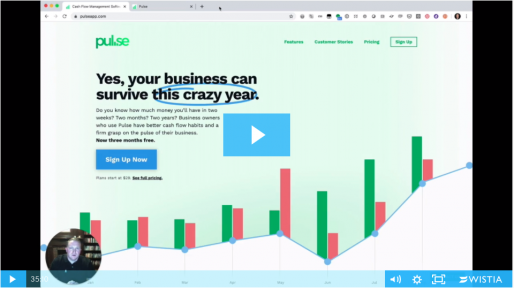Growth in a Downturn: How Arash Fayz of LA Tutoring Pivoted After An 80% Client Drop
Survive & Thrive
Arash Fayz started tutoring others as an undergraduate student in mathematics and computer science at UCLA. When he graduated in 2009, Arash knew his passion was tutoring students and helping them reach new heights.
After a few years of tutoring students individually, Arash founded LA Tutors in 2012. He hired other tutors to grow his business. While it started out offering SAT and ACT prep, LA Tutors now assists students with academic test prep for K-12, college, graduate school, and professional exams.
In addition to adding new tutoring focuses. Arash also expanded the organization outside of Los Angeles to San Francisco and New York.
But the biggest shift for LA Tutors came with the pandemic. The lockdowns forced Arash to pivot his business model and focus on online tutoring services.
We had a chance to sit down and speak with Arash on the Cash Flow Show to learn more about how he managed to quickly scale and adapt his business during the pandemic.
From 80% in-person to fully remote
Instructors with LA Tutors traditionally conducted lessons in person. Even with the opportunity for virtual classes, it was simply easier to arrange meetings at a cafe, library, or another location.
The COVID pandemic and subsequent lockdowns made physical lessons impossible. As a result, LA Tutors faced a drop of 80% in business. Not only were in-person classes off the table, but standardized testing, their most popular service, was largely canceled in 2020.
For Arash, that meant it was time to focus on a new strategy.
“We had used Zoom and other services for the past few years, so we could quickly change gears and work remotely,” says Arash. “And since schools were closed, we shifted our focus to general academics instead of test prep.”
Arash also decided to expand his customer base in San Francisco and New York during the lockdown. Since his team was working from home, scaling his business based on his success in LA was easier than ever. Arash opened offices in these new locations, began advertising for students, and hired new tutors to meet demand. With school closures, parents were looking for online tutors to fill in. When the cities began to reopen, his tutors could meet their students in person.
“We always had the vision that we need to have some budget on the side for potential changes. You always have something on the side in case you need to update your services or train tutors with new technology. Luckily, we had that.”
How was Arash able to quickly change course? He attributes it to his budget for unexpected events.
“We always had the vision that we need to have some budget on the side for potential changes,” notes Arash. “You always have something on the side in case you need to update your services or train tutors with new technology. Luckily, we had that.”
Going into the business, Arash knew that many important topics in the test prep industry today may not be as relevant tomorrow. For example, more and more universities are making the SATs optional. As a result, Arash and his team have to be sensitive to the market and what focus areas will help students succeed. This means being willing to cut services and design new ones to meet the industry shifts.
Using cash flow to balance expenses and growth
LA Tutors’ revenue model follows a common tutoring agency flow:
Clients buy a number of tutoring hours in advance and pay upfront. They may buy 5 hours and use them throughout the month, or 100 hours and space out lessons over the course of a year.
What matters most is the breakdown of expenses, especially with a business that requires new hires to scale.
At LA Tutors, 60-70% of the revenue from a client goes to the tutor. The remaining 30-40% of that money is then divided between:
Office rent
Additional talent
Technology
Since there are costs to hiring and retaining the best talent, Arash and his team project their cash flow 2-to-3 years in advance.
“Given that we’ve been in business for 11 years now, we can look at the records of the previous years and get a good indication of what to plan for,” says Arash.
For example, August is usually a busy time for Arash and his team because students take the SAT and ACT from August to November. Understanding the busiest times of the year helps them allocate resources and promotions accordingly.
Arash also uses cash flow statements to make long-term plans, such as whether LA Tutors should expand to another city or focus more on a particular service.
The most expensive cost outside of hiring tutors is paying for office rent. LA Tutors is located in three of the most high-rent cities. However, since these cities also have high-ranking schools and large populations, they are some of the best places to attract customers.
On the flip side, one of the most essential expenses for Arash and his team is technology. They allocate 5% of their revenue to investing in technology and training.
The payoff of investing in tech
LA Tutors uses 2 main programs to run the business efficiently and keep track of a growing database of clients and instructors:
Salesforce to support staff scheduling
Zapier for automating tasks
Salesforce is a highly customizable reporting and scheduling platform. The LA Tutors team can review which instructor is meeting with which client, how many hours the client has used, and schedule future lessons.
The second crucial software, Zapier, is an automation tool that links other platforms into Salesforce. So, for example, if an instructor schedules a lesson using Zoom, it may be imported into Salesforce automatically.
To ensure that his team is happy with the software and that the investments work as intended, Arash keeps employee feedback loops open. He and the team reevaluate solutions on the market when a software or technology workflow gets negative feedback from several instructors.
“I think that feedback and open communication with staff and employees are super crucial for any business,” says Arash.
Ready to grow your business?
In talking with Arash, it’s clear that smart budgeting and cash flow forecasting play a significant part in business expansion. Using software to help you accurately project and model cash flow can save time and resources. Not only does healthy cash flow make it easier to change services or operations in response to unexpected events, but it also allows business owners to plan years down the road.
Pulse provides at-a-glance reports and comprehensive cash flow forecasting. Built for business owners by business owners, Pulse makes it easy to track and project your cash flow. Try it free for 30 days to see how it can work for you.
Want to read more stories like Arash’s? Subscribe to the Pulse Newsletter, a monthly publication with entrepreneur interviews like this, cash flow advice, and more.


